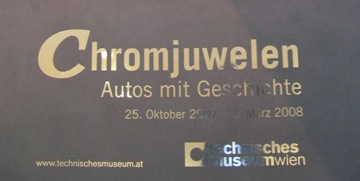--Click the following links to see all the cars-- 1 2 3 4 5 6 7 8 9 10 11 12

36 outstanding exhibits, showcased as Cars with History. The main title, Kings of Chrome, is a metaphor for the vast trove of automotive treasures, for everything thatís shiny; it does not always really have to be chrome.
The exhibition spans a century on at least three different levels of perception: design, aerodynamics, and the personal relationship historical figures have enjoyed with their very special, and quite unique, model.
Design: Between the angular, stately automobile from an Archdukeís stables and the low-slung sculpture of a modern Bugatti lies the entire journey to the far end of the engine bonnet and back again. It begins with the motorized carriage whose outline melted away into the silhouette of the new fundamental rules of engineering. Designs expanded and elongated as a reflection of technical and social success, culminating in the incomparable Bugatti Royale. This is the environment that contains a couple of wonderful examples of Kings of Chrome, in the true sense of the word. Then new technology brought matters back to a shape whose reduced exterior was capable of expressing both top quality and top performance. The exhibition follows each intermediate stage, through to the fascinatingly designed spatial economy of a modern Le Mans winner or a roadworthy 1000 bhp coupť.
The keyword aerodynamics conjures up and showcases the Technical Museumís genius loci in a unique constellation: Beneath the ceiling canopy floats the Taube of aviation pioneer Igo Etrich, a constant across the decades, and below it, in the Kings of Chrome exhibition, we have the opportunity for the first time in ninety years to admire a Prince Heinrich, a model with which design engineer Ferdinand Porsche put into practice the advice given to him by Igo Etrich in 1910 concerning from the coupes and racing cars of the 1920s, 1930s and 1950s, through to the streamlined sleekness of modern vehicles.
Crossing these milestones of fundamental trends in automobile history are the tracks left by the diversity of historical personalities and their vehicles, vehicles they owned and drove themselves or were chauffeured about in: from the Emperorís vehicle to the Popemobile to the car of the founder of Czechoslovakia; from Herbert von Karajanís Ferrari to Price Rainierís Delahaye and the Horch of a Nazi Gauleiter; from Nadja Tillerís Bentley to Stirling Mossís Silver Arrow and the Jagua of Austrian Formula 1 World Champion Jochen Rindt.
What makes this exhibition on home ground at Technisches Museum Wien so special is not just the location, the design and the contents, but the fittingly coherent display of objects born of Austrian engineering skills and a domestic historical reference amidst an international selection of a very special class. It is the modern-day continuation of an institutionís incomparable history in a very special place.
